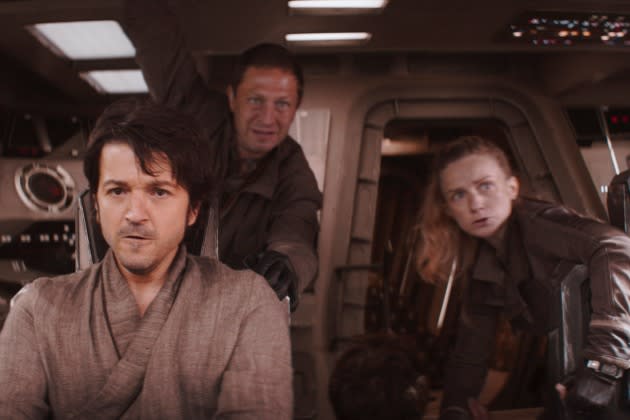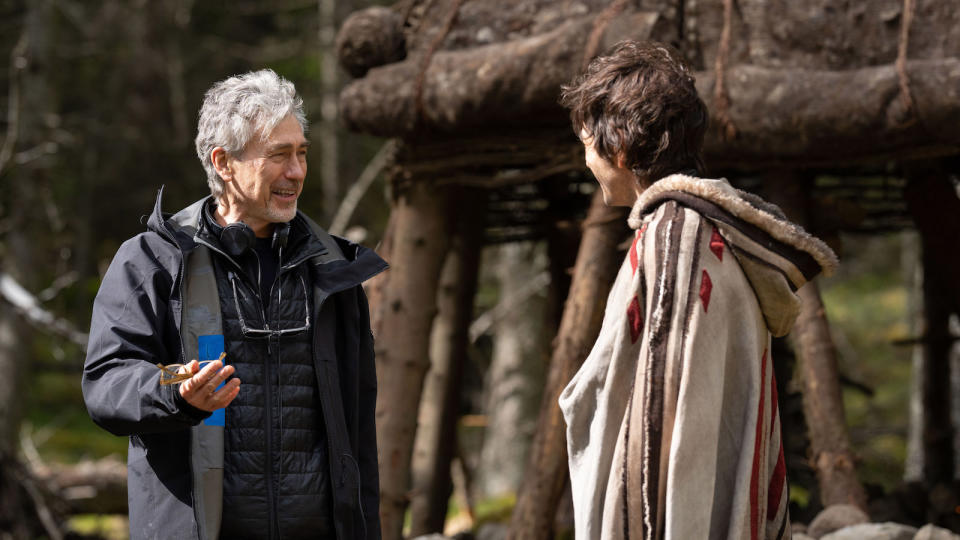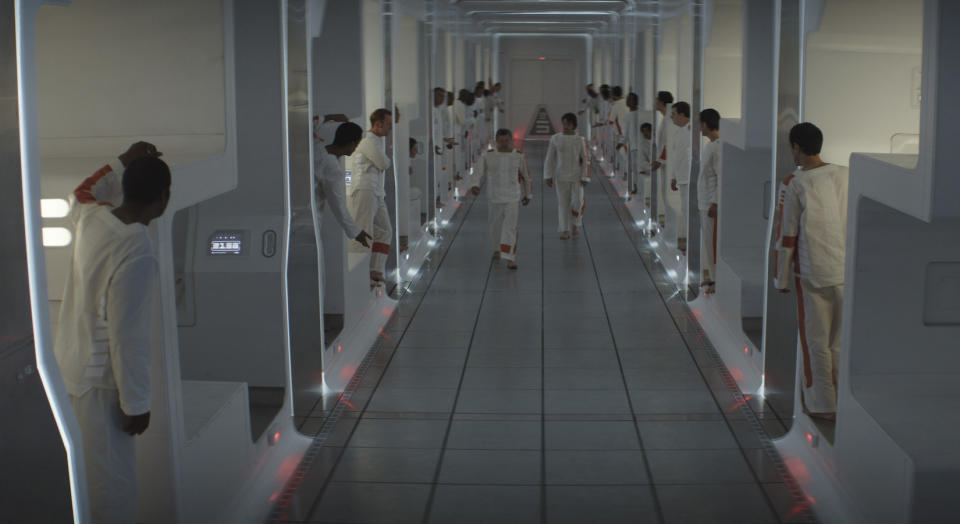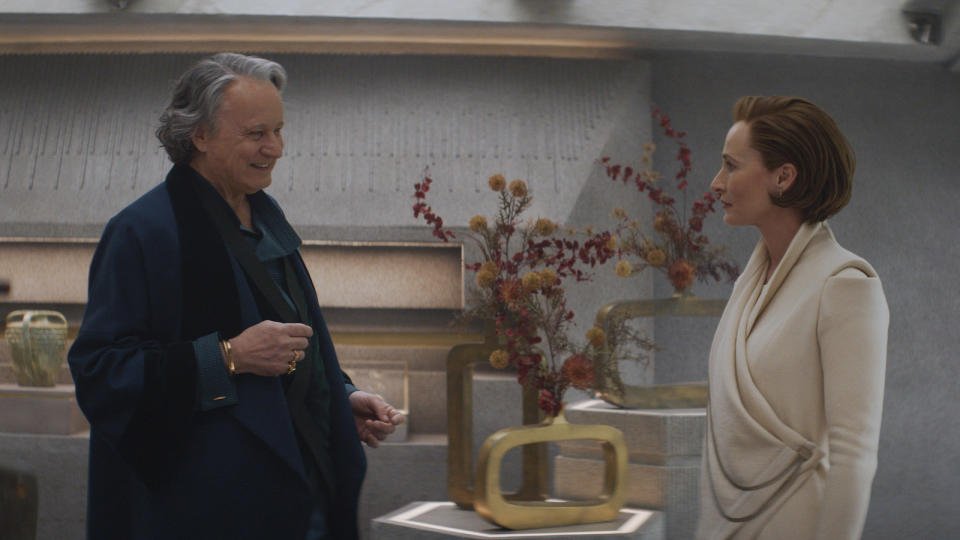Sex and Revolution: ‘Andor’ Showrunner Tony Gilroy on Challenging the Limits of the ‘Star Wars’ Universe

SPOILER WARNING: This story contains discussion of major plot developments through Season 1, Episode 10 of “Andor,” currently streaming on Disney+.
Tony Gilroy knows how people feel about “Andor.” While the veteran screenwriter and director — “The Devil’s Advocate,” the “Bourne” franchise, “Michael Clayton,” “Rogue One: A Star Wars Story” — does not have a presence on social media, he has occasionally dipped into Twitter incognito to see how audiences have been responding to his “Rogue One” prequel series for Disney+.
More from Variety
'Star Wars' and Studio Ghibli Have Made a Baby Yoda Animated Short
'Tulsa King' Is a Rickety Star Vehicle for Sylvester Stallone: TV Review
And? “It’s just the greatest frickin’ thing,” Gilroy says with a massive grin.
As anyone who has watched the show and/or been on Twitter since it debuted Sept. 21 knows, “Andor” has been one of the most enthusiastically well received “Star Wars” projects of the Disney era. Between its sprawling cast and labyrinthine plotting, the 12-episode series has raced headlong into territory many “Star Wars” fans did not know was possible: mature, dramatic storytelling about everyday people. With each new episode, the social media adulation for “Andor” has only grown louder, as millennials and Gen Xers who grew up with “Star Wars” have become further enthralled by the realization that the family-friendly franchise has proven capable of growing up with them.
“I’m trying to find a gear to accept all this, not just affirmation, but just this much engagement with the audience,” Gilroy says of the reaction. “I mean, look, I’ve spent my whole life in a room alone. That’s what we do. There’s no crying about it. But it’s very satisfying to even see people argue about the show.”
Season 1 of “Andor” has tracked the evolution of its title character, Cassian Andor (Diego Luna, who’s also an executive producer), from a self-centered, small-time scoundrel into the revolutionary he becomes in “Rogue One,” through the prism of the dozens of characters he encounters along the way, including rebellion mastermind Luthen Rael (Stellan Skarsgård), disgraced former investigator Syril Karn (Kyle Soller), scrappy revolutionaries Vel Sartha (Faye Marsay) and Cinta Kaz (Varadu Sethu), and irascible prison floor manager Kino Loy (Andy Serkis). Elsewhere, Imperial senator Mon Mothma (Genevieve O’Reilly) strains to navigate her high-profile position while secretly raising funds for the Rebellion, and Imperial security officer Dedra Meero (Denise Gough) single-mindedly hunts for Cassian and (unknowingly) Luthen in her drive to snuff out the insurrectionist group before it grows too powerful.
All of it is at once utterly familiar within the well established world of “Star Wars” and exhilaratingly new, as Gilroy and his small team of writers — namely Dan Gilroy (“Nightcrawler”) and Beau Willimon (“House of Cards”) — have used the show to explore the prickly sacrifices and moral ambiguity of mounting a revolution against an oppressive, autocratic regime.
But while “Andor” spins as complex a narrative web as “Star Wars” has ever seen, it is also, crucially, a rousing, tautly drawn thriller. The season has been grouped into three-episode pods that tell a single overarching story: The failed police raid on Cassian’s adopted home planet of Ferrix after Cassian kills two security officers on Morlana One; a robbery of an Imperial payroll vault on the sleepy planet of Aldhani, which Luthen recruits a reluctant Cassian to join; and, most recently, a prison break from a harrowing labor camp on Narkina 5, where Cassian is sent when he’s accidentally rounded up in a sweeping Imperial police action following the heist on Aldhani.
That last storyline wrapped up on Wednesday with Cassian’s successful escape from the prison, while Dedra tears through Ferrix in her hunt for Luthen and the pressures on Mon Mothma reach a boiling point. Gilroy laughs off a question about what the final organizing genre will be for the season, but he does allow that “there will be a convergence” of the show’s disparate storylines in the final two episodes, which he wrote.
Taking a brief respite from preparing the imminent start of production of Season 2 at Pinewood Studios in London, Gilroy spoke to Variety for a candid and wide-ranging conversation about the show’s surprisingly obscure references “Star Wars” lore, creating the first full-fledged same-sex couple in “Star Wars,” what he makes of fan reaction to the show’s overtly political tone, and his belief that “everybody’s faking it” in the new streaming economy.

Let’s start broadly: How did you approach building Cassian’s arc for the season?
You know where he’s going to end up, so we want to take him as far away as we possibly can be to begin to show his origin story. So this first half of the show was in my mind called The Education of Cassian Endor. How do you take somebody from being a disillusioned, cynical, self-interested loser, to becoming committed to something and understanding what they’re committed to?
We knew what the final scene of the whole season would be. It’s not like there’s an algorithm, but you know intuitively, well, he’s gonna have to go through quite an emotional, philosophical educational odyssey. He’s learning what the rebellion means from multiple intake delivery systems. How many of those can we have and how dramatic can we make them? How can we put that in an adventure story so it doesn’t feel it’s the lesson of the week? That’s the goal.
So each three-episode arc this season has been built around a specific storytelling mechanism: a police raid, a heist, and a prison break. How did you arrive at that device?
Just by pulling the string. This is where he starts. What happens next? Once we start accumulating other characters, then it also becomes a pacing issue of how can they relate to one another and how can we gradually begin to tie everybody together.
It’s kind of like action sequences. I have a couple of directors prepping in Pinewood right now [for season 2], and these big action sequences that we put together, these set pieces, they’re such a mess in the beginning. They’re so incomprehensible. They’re such a pain in the ass. I said to this director, “You’re gonna see when we get there in the end, it’s going to look like it had to be that way. It’s going to look inevitable.” And that’s kind of the process in general. You have all this stuff, and you pull these strings and you try all these different things and we write these scenes and in the end, you go, “Oh, my God, look how smart I was! Of course that had to be there!” In the end, your instinct kind of makes it right.
Did you look at other examples of those genres to draw from or to be in counterpoint to?
I mean, you put “prison” on the table, and everybody’s just like, Well, there’s a high bar. How many absolutely astonishing prison movies are there? If we’re gonna do the heist, it’s like, Oh my god, after listening to Dan Harmon take the heist apart on “Rick and Morty,” you’re like, OK, what are we gonna do?! So the whole goal is to try to turn everything upside down. You’re really excavating for originality all the way down the line, and then hopefully, you can’t be too original at the expense of your story, but that’s the first motivation is how do you turn this inside out so people haven’t seen it before?

So let’s look at the first three episodes that you wrote, which end with the police raid. How did you want to turn that upside down?
I got really interested in how I could weave the origin story of the children on [Cassian’s home planet of] Kenari. I thought Cassian leaving Kenari [as a child] and leaving Ferrix could happen simultaneously. What a great story about someone who’s been ripped out of every place that they ever started to care about. That’s what became interesting to me structurally.
Speaking of Kenari: There are no real adults around, and we see a massive strip mining operation that’s been abandoned. You get this sense that there was some sort of catastrophic accident, but so much of what really happened is left to our imagination. Is that something that you had filled in for yourself?
Yes. I have the answers to that, but I’m not going to get into it. There was a very articulated version of it and then it [was cut] out for different reasons. But it does exist. So we had our own confidence of logic about it. But whatever anybody writes for it themselves, they can write. Doesn’t matter.
The shot of Syril going home on Coruscant, when he gets in an elevator and it goes down — that felt like such a perfect representation of the show, and so unlike what we’re used to seeing on “Star Wars.”
That is Coruscant. Coruscant goes down. George Lucas worked on a project for a decade that was lower Coruscant. I think it was a film and a series and they tried to do a video game. I don’t know the whole story of it, but there’s an incredible amount of work that went into lower Coruscant. It goes down.
So what was your experience like interfacing with “Star Wars” lore? When we talked in August, my impression was you weren’t a deep-dish fan, and yet this show is filled with some of the most arcane “Star Wars” references imaginable. Where did that come from?
I have a bunch of resources. I have Pablo Hidalgo, who’s the Curia in the Vatican at Lucasfilm. I know him from “Rogue One.” Wookieepedia is a tool that one has to really learn how to use, because there are at least four different kinds of canon that I can describe: There’s the movie canon, there’s the movie canon plus the cartoon canon, then there’s the novelized canon, and then there’s fanfiction, which actually forms the largest group of the whole thing. So there’s that.
When it comes to the history of my five years [for the show] — that’s my board. I know the canonical incidents that pertain to my people. When it comes to ships or props or weapons or sometimes planets if we’re not making them up, I’m deeply involved in that. But then the art department will sneak in all that crap into Luthen’s gallery — that, I had no idea. Like, “Oh my God, the thing in the background!” and people are blowing it up. That’s the art department. So many cool people work on the show. There’s a deep geekdom in Pinewood, believe me.

So when Luthen references the Rakatan Invaders, were did that come from?
That was in the script. That’s dialogue. If it’s in dialogue, we’re in charge of it.
So you went on Wookieepedia and you’re, like, I need something extremely old?
Or something that’s applicable. I can’t source the provenance. I don’t know if I called Pablo and said, “Hey, do you got something?” or I found something online and called him and say, “Hey, can I use this? Is this going to be cool? Or has this been retconned already?”
In Val and Cinta, I do believe that you have created the first full-fledged, same-sex couple in live-action “Star Wars” history. What was the conversation with Lucasfilm about that?
Man, really, it was a gesture. There wasn’t any controversy at all. From the very beginning, no one ever said we couldn’t do it and no one ever said, “Oh, God, please do it.” Our whole attitude is it’s just another relationship. I mean, it’s one of the least complicated relationships in the show, if you consider Dedra and Cyril, or Cyril and Eedy, or Perrin and Mon Mothma, their marriage. We did not want it to be performative in any way. There’s things we can’t do — I mean, we have standards and practices. We can’t have sex. There’s a level of violence that we can’t have. There’s limits on what we can do. We can’t do some things that we would want to do. But within that, we’re cool.
It sounds like you weren’t aware that you were making a small bit of history there.
Not really, no. In the blur of the whole thing, it just was like, Oh, this is really cool. I was a little bit naive about that.
So you can’t show sex, but you certainly imply it — the show opens in a brothel, and there’s a post-coital scene in Episode 2.
I wrote that as a challenge. I wrote the first three episodes before we hit the writers’ room. We were still tiptoeing into the relationship with Disney. Is it going to be just a development thing or are we really going to do this? So I definitely was like, “Hey, man, this is what I want to do. Can you take this?” There’s a little bit of a challenge about it.
One tweet that went pretty viral said “Andor” was “fiercely anti-cop” and “anti prison-industrial complex.” The show is about revolution against an oppressive regime — these things are certainly there. But how does it work out in your head?
I have my politics, my worldview, which is probably leaks out into my work in different ways. But I don’t start with an agenda for a show like this. My agenda is the characters. I’ve been reading history for the last 20 years. I’m an old white guy. What do we do? We listen to history podcasts. There’s a great revolutions podcast. I mean, I’ve been studying the Russian revolution for 15 years. All these books that are here in this room.
So revolution, oppression, slavery, imperialism, colonialism — they go back 3,000 years. And a show like this, the great thing is you don’t have to be contemporary. You can drop the needle from any place. You want to do the Haitian revolution for a minute? You want to do the Russian revolution for a minute? I’m cherry picking everything that I know about all those topics, and if anything lands contemporaneously, it’s just like the mirror. It’s not a sneaky answer, either. I’m not trying to make a commentary on contemporary politics. It’s funny watching — because I have seen some of the stuff — people try to twist themselves to get on either side of the conversation. To me, that’s why this turned out to be such a great place for me to be right now, because I can talk about anything and not get in trouble.

How have you felt about how the show has been presented to the world?
In what sense?
I think this show has been a bit of a sneak attack for a lot of viewers. I don’t know if it felt as big of a deal going in as it has felt while watching it.
I’m very pleased with what they did. The materials are great. I think I was surprised. I thought the show would go the other way, that we would have this gigantic, instantaneous audience that would just be everywhere, but that it would take forever for non-“Star Wars” people or critics or my cohort of friends to get involved in the show. The opposite happened. We ended up with all this critical praise, all this deep appreciation and understanding from really surprising number of sources, and we’re chasing the audience.
I’ll say this, because it’s a trade publication. Everybody is trying to pretend that this is business as usual: “Oh, there’s a comp for this, and there’s a comp for that. And this is how we do it.” And everybody is faking it. This is an entirely new business. Everybody’s trying to figure it out. You have business affairs trying to pretend with streaming that they understand it and how artists should get paid. We’re going to have a whole bunch of labor issues that are going to come up because of that.
No one’s ever launched these aircraft carriers before, these gigantic shows. I mean, our show has a budget. We’re tight. But there are shows out there without budgets, really. I mean, there’s some things going on out there that are just like, holy crap!
Two of those event series — “The Lord of the Rings: The Rings of Power” and the “Game of Thrones” prequel “House of the Dragon” — debuted right when “Andor” was originally supposed to premiere in late August.
I never heard about it until, like, the end of July. I was like, “Oh boy, that’s funky. Maybe we should move our date.” And then they were like, “We’re gonna move our date.” I mean, it’s not like the old movie business where everybody was doing something for the 100th time. Everything is brand new.
I think it’s really fascinating. I’m really happy I lived long enough to be part of it. The only thing I don’t like is people pretending as if they know what they’re doing, or pretending as if this is business as usual, because it’s just not. Do you feel that same way?
Yes, completely. And now you’re about to start launching your second aircraft carrier with Season 2 of “Andor.” When we talked in August, you said you didn’t think you would do something else with “Star Wars” after you’d finished this show. Do you see yourself doing anything like it, though, with another legacy franchise?
If I said something that was definitive before, you must have caught me half-drunk or something. I’m trying to survive this. It’s another two years. I’m not complaining, but it’s just a motherfucker amount of work, man, and it just never ends. We have these T-shirts now for everybody in Pinewood [with a line from “Andor”]: “One way out.” The one way out is we have to do the next 12. I would really love to come to the end of it and be healthy and invigorated to try to think about what to do, but part of me thinks I’ll probably be in a fetal position some place for a few months. I’m trying to get to February where all my scripts will be tight and all the directors will be in play. That’s my goal line.
This interview has been edited and condensed.
Best of Variety
Sign up for Variety’s Newsletter. For the latest news, follow us on Facebook, Twitter, and Instagram.

 Yahoo Movies
Yahoo Movies 
